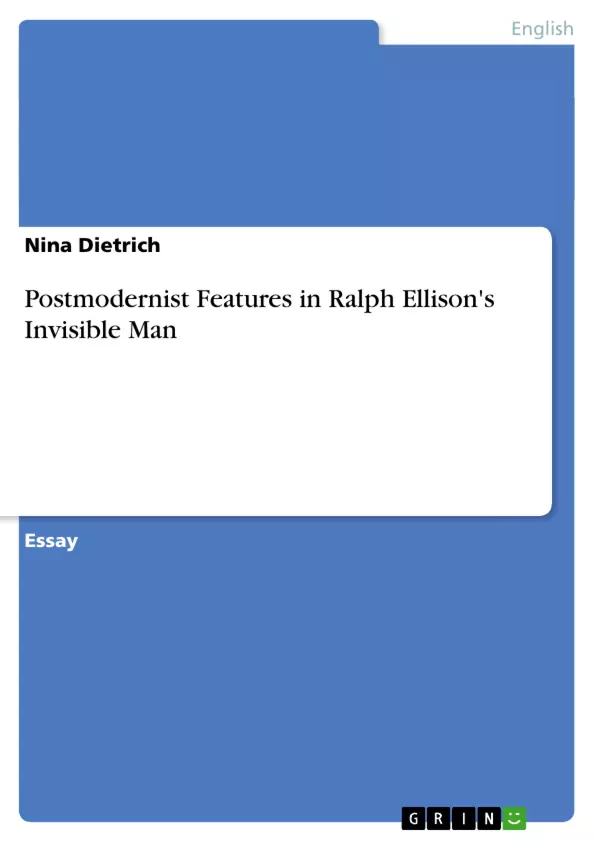In an attempt to place Ralph Waldo Ellison’s novel Invisible Man within a
Modernist framework, Berndt Ostendorf writes,
‘Ellison … is a “Spätling,” a latecomer to Modernism. … Ellison’s Modernism
… is not one of crisis and despair, but of innovation and hope. He accepts the
discipline implied in [Ezra Pound’s] slogan “make it new,” but rejects the
cultural pessimism of his ancestors.’1
Although Ostendorf’s description is right insofar that Ellison’s work is optimistic in its
outcome rather than as pessimistic as the majority of modernist novels, it does not seem
to be in agreement with the term Modernism in general. Isn’t modernist literature
usually called a ‘literature of … crisis’?2 Isn’t Modernism said to feature ‘elements of
cultural apocalypse’ rather than the hope Ostendorf mentions?3 And: Doesn’t
Ostendorf’s statement resemble a definition of Postmodernism rather than Modernism?
In fact, Ellison’s novel is hard to categorize. Critics agree that Invisible Man includes
characteristics of different literary periods. Malcolm Bradbury, for instance, says the
novel mixes ‘naturalism, expressionism, and surrealism’ and thereby places it
somewhere between Modernism and Postmodernism.4 As these two terms are
problematic as far as their definitions are concerned, this essay will begin by naming
some of the key characteristics of both periods. Later on, the essay will point out a
number of typically postmodern features that Ellison integrates into Invisible Man and
give examples from the novel itself. Eventually, the essay will discuss whether Invisible
Man should be considered a modernist or postmodernist novel.
1 Berndt Ostendorf, ‘Anthropology, Modernism, and Jazz’, in Harold Bloom, Ralph
Ellison, Chelsea House Publishers, 1986, pp. 161 - 164
2 Peter Childs, Modernism, Routledge, 2000, p.14
3 Malcolm Bradbury in A Dictionary of Modern Critical Terms, ed. Roger Fowler, as
quotes in Childs, Op. Cit., p. 2
4 Malcolm Bradbury, The Modern American Novel, 2nd edition, Oxford University
Press, 1992, p. 166
Inhaltsverzeichnis (Table of Contents)
- Postmodernist Features in Ralph Ellison's Invisible Man
- Introduction: Modernism and Postmodernism
- The Fragmentation of Truth and Identity
- The Multitude of Selves: Rinehart and the Narrator
Zielsetzung und Themenschwerpunkte (Objectives and Key Themes)
This essay aims to analyze the postmodernist features present in Ralph Ellison's novel "Invisible Man," examining how these elements contribute to the understanding of the main character's struggle for identity and his experiences of invisibility in a racially stratified American society.
- The concept of fragmentation in postmodernism and its implications for identity.
- The rejection of a single, unified truth and the embrace of multiple perspectives.
- The influence of postmodernist thinkers like Jean-François Lyotard and Jean Baudrillard on Ellison's work.
- The role of the narrator's shifting identities in shaping his understanding of himself and the world.
- The interplay between individual identity and societal structures in a postmodern context.
Zusammenfassung der Kapitel (Chapter Summaries)
- Introduction: Modernism and Postmodernism: This section establishes the theoretical framework for analyzing "Invisible Man," exploring the key characteristics of both Modernism and Postmodernism, and highlighting the difficulties in definitively categorizing Ellison's work within either period.
- The Fragmentation of Truth and Identity: This chapter delves into the central tenets of Postmodernism, particularly its emphasis on the fragmentation of truth and the concept of multiple selves. It contrasts the modernist nostalgia for a unified past with the postmodern celebration of fragmentation.
- The Multitude of Selves: Rinehart and the Narrator: This chapter analyzes the role of the character Rinehart, a man with a multitude of identities, as a representation of the fragmented self in a postmodern world. It also explores the narrator's own journey through multiple identities, starting with a naive acceptance of societal norms and progressing towards a more complex and liberated understanding of selfhood.
Schlüsselwörter (Keywords)
This essay focuses on key terms and concepts from Postmodernism, including fragmentation, multiplicity, identity, invisibility, and the rejection of essentialism. It also examines the role of societal structures, particularly racism, in shaping the individual's experience and sense of self in a postmodern context. The analysis will consider themes of social alienation, cultural identity, and the challenges of navigating a complex and often contradictory world.
- Citar trabajo
- Nina Dietrich (Autor), 2003, Postmodernist Features in Ralph Ellison's Invisible Man, Múnich, GRIN Verlag, https://www.grin.com/document/19972



